Food Preservation: Know Your Sources
go.ncsu.edu/readext?734448
en Español / em Português
El inglés es el idioma de control de esta página. En la medida en que haya algún conflicto entre la traducción al inglés y la traducción, el inglés prevalece.
Al hacer clic en el enlace de traducción se activa un servicio de traducción gratuito para convertir la página al español. Al igual que con cualquier traducción por Internet, la conversión no es sensible al contexto y puede que no traduzca el texto en su significado original. NC State Extension no garantiza la exactitud del texto traducido. Por favor, tenga en cuenta que algunas aplicaciones y/o servicios pueden no funcionar como se espera cuando se traducen.
Português
Inglês é o idioma de controle desta página. Na medida que haja algum conflito entre o texto original em Inglês e a tradução, o Inglês prevalece.
Ao clicar no link de tradução, um serviço gratuito de tradução será ativado para converter a página para o Português. Como em qualquer tradução pela internet, a conversão não é sensivel ao contexto e pode não ocorrer a tradução para o significado orginal. O serviço de Extensão da Carolina do Norte (NC State Extension) não garante a exatidão do texto traduzido. Por favor, observe que algumas funções ou serviços podem não funcionar como esperado após a tradução.
English
English is the controlling language of this page. To the extent there is any conflict between the English text and the translation, English controls.
Clicking on the translation link activates a free translation service to convert the page to Spanish. As with any Internet translation, the conversion is not context-sensitive and may not translate the text to its original meaning. NC State Extension does not guarantee the accuracy of the translated text. Please note that some applications and/or services may not function as expected when translated.
Collapse ▲With more people staying closer to home and more interest in home gardening, there appears to be an increase in preserving foods at home this year. That makes this a good time to remind everyone about the need to have up-to-date instructions and procedures. Food preservation techniques are constantly being studied and revised. Just because “you’ve always don’t it this way” or this is how your mother (or grandmother) taught you, may not be the most up-to-date method. Also, just because you found a recipe on the internet, Pinterest, or saw it on a cooking show on television does not make it SAFE.
When answering questions about food preservation, we often seek the assistance of “So Easy to Preserve” (6th edition, 2014) a recipe and instruction book from the University of Georgia Cooperative Extension. Many consider this to be the best reference available on the topic. You can purchase the book directly from UGA and the National Center for Home Food Preservation (NCHFP). The NCHFP is recognized as a reliable and research-based source of food preservation information and their website has a wealth of information available free-of-charge.
Debbie Stroud from N.C. Cooperative Extension’s Safe Plates Information Centers conducts a live class each week on Facebook. It’s every Wednesday at 12:30 p.m. and called #WednesdayStash. You can find it at the Safe Plates Food Safety Information Center on Facebook.
Source: Cheryle Jones Syracuse, Family and Consumer Science staff member Cheryle_Syracuse@ncsu.edu




